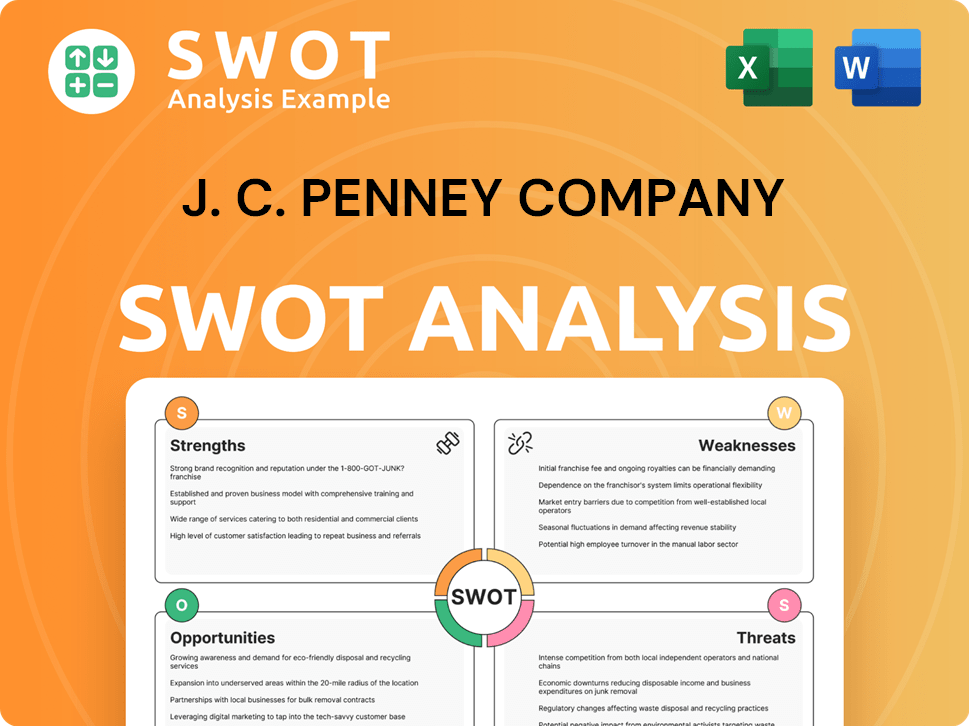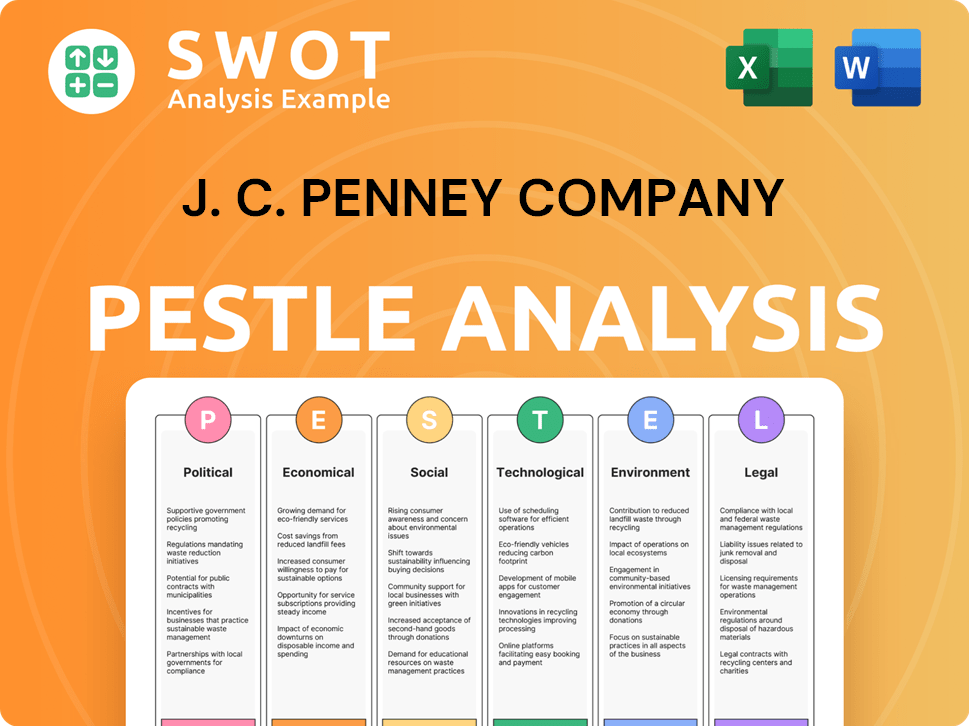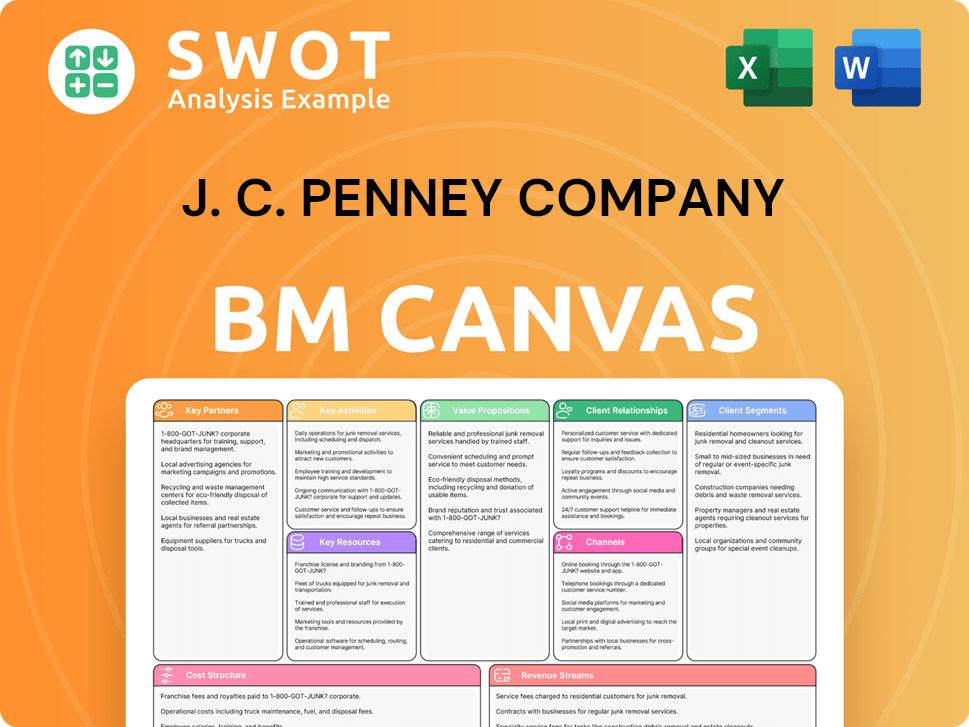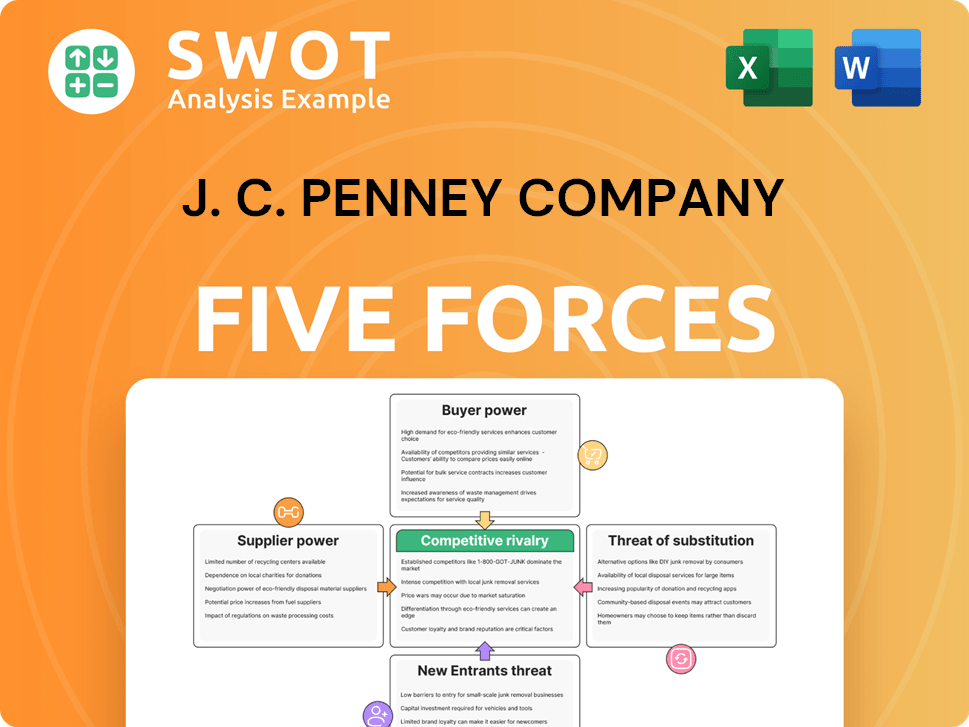J. C. Penney Company Bundle
Can J. C. Penney Reclaim Its Retail Throne?
From its humble beginnings in 1902, J. C. Penney has navigated a century of retail evolution. Today, the company is undergoing a significant transformation, aiming to revitalize its brand and recapture consumer interest. This article dives into the J. C. Penney Company SWOT Analysis to uncover the strategies behind its comeback.

This exploration of the J. C. Penney sales strategy and J. C. Penney marketing strategy will analyze its recent "Yes, JCPenney" campaign, unveiled in April 2025, and its $1 billion investment plan. We'll examine the JCP marketing plan, including its digital marketing strategy, customer acquisition strategies, and brand positioning strategy within the competitive department store sales landscape. Understanding J. C. Penney's business model and its omnichannel strategy is crucial to grasping its future marketing trends and how it aims to attract customers.
How Does J. C. Penney Company Reach Its Customers?
The company, formerly known as J. C. Penney Company, employs a dual sales strategy, leveraging both online and offline channels to engage with its customers. This approach includes a significant physical retail presence across the United States, complemented by a robust e-commerce platform. This integrated strategy is crucial for the company's overall J. C. Penney sales strategy and JCP marketing plan.
As of 2023, the company operated over 650 physical retail locations across the USA. While the number of physical stores has decreased over the last decade, the company remains a major player in the apparel and home goods retail sector. The company's e-commerce platform, jcp.com, has played an increasingly vital role since its launch in 1998. This digital presence is integral to the company's J. C. Penney marketing strategy.
The company's sales channels have evolved strategically over time, adapting to changes in the retail landscape. Originally, stores were located in downtown areas. With the rise of shopping malls, the company shifted its focus to anchor mall locations. More recently, the company has opened stores in power centers and stand-alone locations. The company is actively investing in enhancing its digital capabilities, upgrading its website and mobile app to create a seamless omnichannel experience. This approach allows customers to shop online, in-store, and through mobile devices.
The company's online sales are a crucial part of its revenue. In Q1 2024, online sales reached $86.7 million, highlighting the company's focus on improving its digital presence. Digital Commerce 360 projects that online sales in 2024 will reach $2.26 billion.
The company has engaged in key partnerships to contribute to its growth and market share. Notable product collaborations include Sephora, though this partnership ended in 2022. The company launched JCPenney Beauty in 2022, and in 2024, shifted to purchasing directly from beauty brands. Strategic partnerships with popular brands and designers, such as Disney, are also important.
In January 2025, the company merged with SPARC Group to form Catalyst Brands. This new entity has over $9 billion in revenue and 1,800 physical store locations. This merger brings together the company's private labels with SPARC Group's brands, enhancing its distribution network and consumer reach.
In October 2024, the company extended its long-term financing partnership with Synchrony. This partnership added 'Buy Now, Pay Later' installment loans, particularly for fine jewelry purchases over $300, enhancing customer purchasing flexibility.
The company's omnichannel strategy integrates online and offline channels to provide a seamless shopping experience. This approach is critical for retail marketing and ensuring customer satisfaction, allowing customers to shop across various touchpoints. The company's investment in digital capabilities, upgrading its website, and mobile app with improved search functionality, product details, and customized recommendations, aims to create a cohesive experience.
- Enhanced website and mobile app features improve user experience.
- Seamless integration between online and in-store shopping.
- Focus on customer reviews and personalized recommendations.
- Strategic partnerships to expand product offerings and reach.
For a deeper dive into the company's strategic direction, consider exploring the Growth Strategy of J. C. Penney Company, which provides additional insights into the company's business model and future plans.
J. C. Penney Company SWOT Analysis
- Complete SWOT Breakdown
- Fully Customizable
- Editable in Excel & Word
- Professional Formatting
- Investor-Ready Format

What Marketing Tactics Does J. C. Penney Company Use?
The company employs a multifaceted approach to sales and marketing, integrating both digital and traditional methods to enhance brand awareness and drive sales. Their marketing strategy is designed to engage customers across various platforms, from social media to television, ensuring a broad reach. This comprehensive approach is critical for maintaining a competitive edge in the retail sector.
The company's marketing tactics are continually evolving, with a strong emphasis on data-driven insights and customer personalization. By leveraging data analytics, the company aims to tailor marketing campaigns to specific customer segments, thereby increasing customer loyalty and repeat purchases. This strategy reflects a commitment to adapting to changing consumer behaviors and preferences.
The company's marketing plan includes digital strategies like content and email marketing, and social media campaigns to promote offers and sales. They also use influencer partnerships and celebrity endorsements to boost brand visibility.
The company utilizes digital marketing through content marketing, email marketing, and social media. They promote offers, discounts, and upcoming sales across these digital channels. The focus is on maintaining brand awareness and driving online engagement.
The company collaborates with influencers and celebrities to broaden its reach. Notable partnerships have included celebrities like Martha Stewart and Shaquille O'Neal. They also work with social media creators for specific promotions.
The company emphasizes data-driven marketing, customer segmentation, and personalization. They use data analytics to create personalized campaigns, targeting specific customer segments with relevant offers. This strategy aims to increase loyalty and repeat purchases.
The company is leveraging AI and augmented reality (AR) tools, such as the AI Skincare Advisor. In Q1 2024, this led to a 23% higher average order value and 103% more time spent on the site for users. These tools also enhance data collection.
The company continues to use traditional media, including TV advertising. They air new TV spots as part of campaigns like 'Yes, JCPenney' on shows such as 'Jimmy Kimmel Live!'. This helps maintain brand visibility through established channels.
The company is updating its website and mobile app with improved search functionality, product details, customer reviews, and customized recommendations. They are focused on integrating online and in-store experiences for a seamless customer journey.
The company is investing in AI and machine learning for supply chain optimization, which improved delivery times by half a day in Q4 2023. They also offer unique services such as free family portraits and children's haircuts as promotional tactics. These initiatives support the overall Growth Strategy of J. C. Penney Company.
- AI and Machine Learning: Implementing AI and machine learning in merchandising, planning, and supply chain optimization to improve operational efficiency.
- Customer-Centric Services: Offering unique services like free family portraits and children's haircuts to attract customers and enhance the shopping experience.
- Supply Chain Optimization: Improving delivery times through technology and process enhancements.
- Digital Transformation: Enhancing the website and mobile app with improved search, product details, and customer reviews to provide a better online experience.
J. C. Penney Company PESTLE Analysis
- Covers All 6 PESTLE Categories
- No Research Needed – Save Hours of Work
- Built by Experts, Trusted by Consultants
- Instant Download, Ready to Use
- 100% Editable, Fully Customizable

How Is J. C. Penney Company Positioned in the Market?
The brand positioning of J. C. Penney focuses on being a mid-scale American department store chain. It offers affordable and stylish options, primarily targeting families, Millennials, and average-income customers. The core message emphasizes quality products at accessible prices, aiming to make fashion accessible to everyone across various categories like apparel, beauty, jewelry, and home goods. This approach is central to its JCP marketing plan.
The company differentiates itself by offering a wide range of products, strong brand recognition, and a loyal customer base. Customers value affordability, a family-focused shopping experience, and quality. JCPenney leverages its customer loyalty program, JCPenney Rewards, to enhance customer retention. This program has approximately 10 million active members, representing about 30% of its customer base.
JCPenney is actively working to shift consumer perceptions and respond to competitive threats. The 'Yes, JCPenney' brand positioning, launched in April 2025, aims to surprise shoppers with the breadth and value of its current offerings. This campaign focuses on showcasing on-trend goods at budget prices, aiming to create an 'epiphany' about what JCPenney offers, from fashion to in-store services. This is a key element of its J. C. Penney sales strategy.
JCPenney's brand positioning centers on providing value and style to families and a broad customer base. This approach is a core element of its J. C. Penney marketing strategy. The company emphasizes a family-focused shopping experience, making it a key aspect of its brand identity.
The company competes with rivals like Macy's and Kohl's by offering a broad product range, strong brand recognition, and a loyal customer base. This is further supported by its customer loyalty program and a focus on affordability as a key differentiator. The article Revenue Streams & Business Model of J. C. Penney Company provides additional insights.
The core message emphasizes quality products at affordable prices, making fashion accessible to everyone. It aims to create a consistent brand experience across all channels and touchpoints. Ongoing investments in store refreshes and technology upgrades enhance the in-store and online customer experience.
The 'Yes, JCPenney' campaign seeks to change consumer perceptions by showcasing the breadth and value of its offerings. The company focuses on on-trend goods at budget prices to create a positive perception. It also emphasizes customer service as a core component of its brand identity.
J. C. Penney Company Business Model Canvas
- Complete 9-Block Business Model Canvas
- Effortlessly Communicate Your Business Strategy
- Investor-Ready BMC Format
- 100% Editable and Customizable
- Clear and Structured Layout

What Are J. C. Penney Company’s Most Notable Campaigns?
The sales and marketing strategies of J. C. Penney Company (JCPenney) have been significantly reshaped through several key campaigns designed to revitalize the brand and drive growth. These initiatives focus on attracting and retaining customers, enhancing brand perception, and adapting to evolving consumer preferences. The JCP marketing plan includes a multi-faceted approach to increase sales and strengthen its position in the competitive retail market.
Recent campaigns leverage digital platforms, celebrity partnerships, and innovative advertising techniques to engage consumers. These strategies also aim to capitalize on emerging trends, such as the renewed interest in shopping malls among younger generations, and to enhance the overall customer experience. Through these concerted efforts, JCPenney is working to redefine its brand identity and reinforce its value proposition.
The company's commitment to adapting to market changes is evident in its substantial investment plans, including initiatives to upgrade stores and enhance digital capabilities. These efforts align with the overall goal of improving customer satisfaction and driving long-term growth. The goal is to establish JCPenney as a relevant player in the retail landscape.
Launched in late 2024, this ongoing campaign offers exclusive weekly deals, blending entertainment with savings. It featured celebrity partners like Martha Stewart and Shaquille O'Neal. This strategy aims to attract and retain shoppers, driving traffic and exceeding sales expectations for specific deals, such as a $20 denim deal and a $699 diamond deal, which both outperformed expectations by over 200%.
The Lionel Messi fragrance deal achieved the highest penetration of new customers at 30%. Furthermore, 75% of existing customers purchased a fragrance for the first time. This campaign demonstrates the effectiveness of targeted promotions in attracting new customers and driving sales of specific products within the JCPenney portfolio.
These ads, seen in high-traffic areas like Times Square, featured stylish looks with QR codes. Items sold five times faster than average, with many becoming hot items. This approach highlights the effectiveness of innovative advertising in driving immediate sales and creating buzz around specific products. This initiative is part of the J. C. Penney sales strategy.
Launched in April 2025, this campaign aims to subvert consumer expectations and encourage reconsideration of the department store. Out-of-home ads with copy like 'It's from where?' and QR codes reveal the JCPenney origin. The goal is to highlight the brand's contemporary fashion and in-store services, targeting those with neutral or negative perceptions. This is a key component of the JCP marketing plan.
In April 2024, JCPenney simplified its loyalty program, nearly doubling the rate of rewards for members. This enhancement is part of a broader customer experience strategy. This initiative is part of a larger $1 billion reinvestment plan by fiscal year 2025, which also includes enhancing digital capabilities and upgrading stores.
- Focus on customer retention.
- Increased rewards to drive repeat purchases.
- Improve customer loyalty.
- Part of the J. C. Penney customer acquisition strategies.
J. C. Penney Company Porter's Five Forces Analysis
- Covers All 5 Competitive Forces in Detail
- Structured for Consultants, Students, and Founders
- 100% Editable in Microsoft Word & Excel
- Instant Digital Download – Use Immediately
- Compatible with Mac & PC – Fully Unlocked

Related Blogs
- What are Mission Vision & Core Values of J. C. Penney Company Company?
- What is Competitive Landscape of J. C. Penney Company Company?
- What is Growth Strategy and Future Prospects of J. C. Penney Company Company?
- How Does J. C. Penney Company Company Work?
- What is Brief History of J. C. Penney Company Company?
- Who Owns J. C. Penney Company Company?
- What is Customer Demographics and Target Market of J. C. Penney Company Company?
Disclaimer
All information, articles, and product details provided on this website are for general informational and educational purposes only. We do not claim any ownership over, nor do we intend to infringe upon, any trademarks, copyrights, logos, brand names, or other intellectual property mentioned or depicted on this site. Such intellectual property remains the property of its respective owners, and any references here are made solely for identification or informational purposes, without implying any affiliation, endorsement, or partnership.
We make no representations or warranties, express or implied, regarding the accuracy, completeness, or suitability of any content or products presented. Nothing on this website should be construed as legal, tax, investment, financial, medical, or other professional advice. In addition, no part of this site—including articles or product references—constitutes a solicitation, recommendation, endorsement, advertisement, or offer to buy or sell any securities, franchises, or other financial instruments, particularly in jurisdictions where such activity would be unlawful.
All content is of a general nature and may not address the specific circumstances of any individual or entity. It is not a substitute for professional advice or services. Any actions you take based on the information provided here are strictly at your own risk. You accept full responsibility for any decisions or outcomes arising from your use of this website and agree to release us from any liability in connection with your use of, or reliance upon, the content or products found herein.